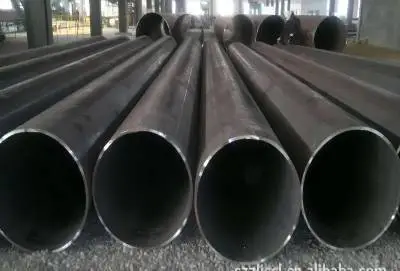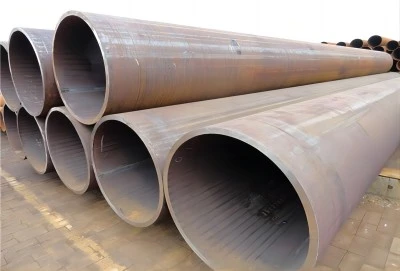In the world of steel pipe manufacturing, Double Submerged Arc Welding (DSAW) stands out as a highly efficient and reliable method for producing large-diameter, thick-walled pipes. This process has revolutionized the industry, offering superior weld quality and improved productivity. In this comprehensive guide, we'll explore the DSAW pipe welding process, its key steps, and the advantages it offers over other welding methods.
|
|
|
What is Double Submerged Arc Welding (DSAW)?
Double Submerged Arc Welding, commonly known as DSAW, is an advanced welding technique used in the production of large-diameter steel pipes. This method involves welding both the inside and outside of the pipe simultaneously, using two or more welding arcs submerged under a blanket of granular flux material.
The term "submerged" refers to the fact that the welding arc is not visible, as it occurs beneath the layer of flux. This flux serves multiple purposes: it protects the weld pool from atmospheric contamination, stabilizes the arc, and provides alloying elements to the weld metal.
DSAW is particularly well-suited for manufacturing pipes with wall thicknesses ranging from 6mm to 50mm and diameters from 16 inches to 100 inches. These pipes are commonly used in oil and gas pipelines, offshore platforms, and other high-pressure applications where strength and reliability are paramount.
Key Steps Involved in the DSAW Pipe Welding Process
The DSAW pipe welding process involves several critical steps, each contributing to the final product's quality and integrity. Let's break down these steps:
- Pipe Preparation: The process begins with the careful preparation of the pipe edges. The steel plate is formed into a cylindrical shape, and the edges are beveled to create a suitable joint configuration for welding.
- Tack Welding: Once the pipe is formed, it is tack welded along the seam to hold it in shape. This step ensures that the pipe maintains its circular profile during the welding process.
- Flux Application: A layer of granular flux is applied to both the inside and outside of the pipe along the welding seam. This flux plays a crucial role in protecting the weld pool and stabilizing the arc.
- Welding Process: The actual welding process involves two or more welding heads operating simultaneously on both sides of the pipe. The welding arc is struck beneath the flux layer, creating a molten pool that fuses the pipe edges together.
- Flux Recovery: As the welding progresses, the unused flux is recovered and recycled for future use, making the process more economical and environmentally friendly.
- Cooling and Solidification: After welding, the pipe is allowed to cool naturally. The weld metal solidifies, forming a strong, continuous joint along the pipe's length.
- Post-Weld Heat Treatment: Depending on the pipe's intended application and material specifications, a post-weld heat treatment may be applied to relieve internal stresses and improve the weld's mechanical properties.
- Quality Control: The final step involves rigorous quality control measures, including visual inspection, non-destructive testing (such as ultrasonic or radiographic inspection), and mechanical testing to ensure the pipe meets all required specifications.
Throughout these steps, precise control of welding parameters such as current, voltage, travel speed, and flux composition is crucial to achieving high-quality welds consistently.
Advantages of DSAW over Other Welding Methods
The DSAW process offers several significant advantages over other welding methods, making it the preferred choice for many large-scale pipe manufacturing applications:
- High Deposition Rate: DSAW can achieve welding speeds of up to 2 meters per minute, significantly faster than many other welding processes. This high deposition rate translates to increased productivity and reduced manufacturing times.
- Excellent Weld Quality: The submerged arc process produces clean, high-quality welds with minimal defects. The flux covering protects the weld pool from atmospheric contamination, resulting in welds with excellent mechanical properties.
- Deep Penetration: DSAW can achieve deep weld penetration, making it ideal for thick-walled pipes. This deep penetration ensures full fusion of the joint, contributing to the overall strength and integrity of the pipe.
- Consistency: The automated nature of the DSAW process ensures consistent weld quality along the entire length of the pipe, reducing the likelihood of human error.
- Versatility: DSAW can be used with a wide range of pipe diameters and wall thicknesses, making it a versatile choice for various applications in industries such as oil and gas, petrochemical, and construction.
- Cost-Effectiveness: Despite the initial equipment investment, DSAW is cost-effective for large-scale production due to its high productivity, low labor requirements, and efficient use of welding consumables.
- Improved Working Conditions: The submerged nature of the welding arc reduces harmful UV radiation and fume emissions, creating a safer working environment for operators.
- Reduced Post-Weld Processing: The high-quality welds produced by DSAW often require minimal post-weld processing, saving time and resources in the manufacturing process.
These advantages make DSAW an attractive option for manufacturers looking to produce high-quality, large-diameter pipes efficiently and cost-effectively.
Contact Us
The Double Submerged Arc Welding (DSAW) process has revolutionized the production of large-diameter, thick-walled steel pipes. Its ability to produce high-quality welds consistently, coupled with its high productivity and cost-effectiveness, has made it an indispensable method in the pipe manufacturing industry.
As industries continue to demand stronger, more reliable pipes for challenging applications, the importance of advanced welding techniques like DSAW cannot be overstated. By understanding the process, its key steps, and its advantages, manufacturers can make informed decisions about their production methods and deliver superior products to meet the evolving needs of their customers.
For those seeking high-quality, large-diameter steel pipes produced using state-of-the-art welding techniques, look no further than Longma Group. As one of China's leading ERW/LSAW steel pipe manufacturers since 2003, Longma Group specializes in the production of large-diameter, thick-walled, double-sided, sub-arc-seam welding steel pipes. With an annual output exceeding 1,000,000 tons as of 2023, Longma Group has the expertise and capacity to meet your steel pipe needs. For more information or to discuss your requirements, please contact us at info@longma-group.com.














